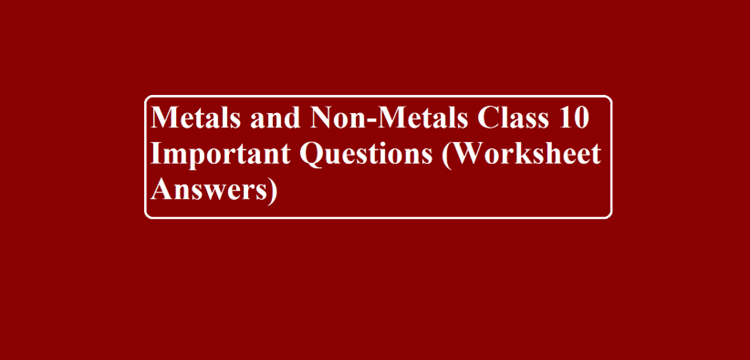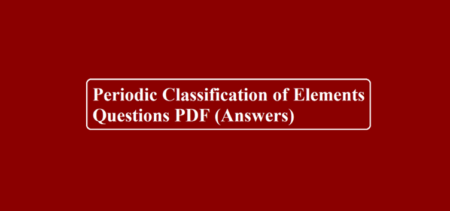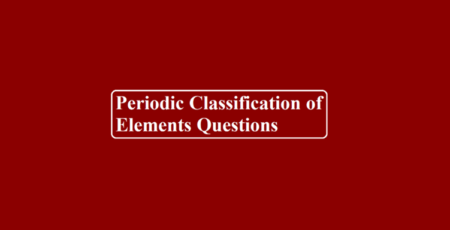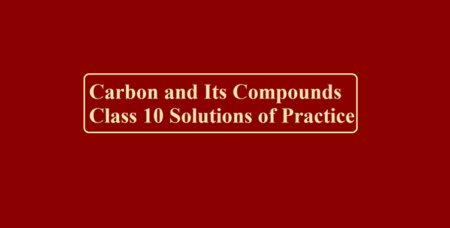Metals and Non-Metals Class 10 Important Questions (Worksheet Answers)
metals and non metals class 10 important questions with answers
Ans 1. Calcium form hydrogen gas in reaction with water, bubbles of hydrogen gas stick to the calcium metal and that is why calcium floats in water.
Ca(s) + 2H2O(l) → Ca(OH)2 (aq) + H2 (g)
Ans 2. (a) Carbon makes it hard and strong. Tungsten also makes it hard and strong.
(b) Mercury is alloyed with metals to form an amalgam.
(c) Zinc metal is used for coating over iron metal to galvanise iron.
(d) Silver articles acquire black coating when left exposed to the atmosphere.
Ans 3. Sodium chloride is an ionic compound and it forms ions in water, therefore it is soluble in water whereas kerosene is a non-polar covalent compound, NaCl does not form ions in kerosene, therefore, it is insoluble in it.
Ans 4. Copper is more reactive than Ag, therefore it can displace Ag from the AgNO3 solution.
Cu(s) + 2AgNO3 (aq) → Cu(NO3)2 (aq) + 2Ag(s)
Ans 5. (a) It is easier to reduce an oxide than sulphide and carbonate ores.
(b) It is due to strong forces of attraction between positive and negative ions.
(c) Hydrogen forms H+ ions like metals, therefore it is included in the activity series.
(d) Zinc is more reactive than iron, therefore it will get easily oxidised in preference to Fe and hence protect the iron from rusting even if zinc coating is broken.
Ans 6. The method is alloy formation, by adding a suitable metal or a non-metal. Alloy is. a homogeneous mixture of two or more metals. One of them can be a non-metal also. This process is called alloying.
Ans 7. (a) They are soluble in water.
(b) They are hard but brittle solids.
(c) They conduct electricity in a solid state and in their aqueous solution.
(d) They have high melting and boiling points
Ans 8. (a) These metals get corroded. Silver forms black Ag2S (silver sulphide) and copper form a greenish layer of basic copper carbonate CuCO3. Cu(OH)2.
(b) Tamarind contains acid which reacts with basic copper carbonate and the product gets dissolved and removed from the copper vessel.
(c) Aluminium forms an oxide layer on its surface which does not further react with air.
Ans 9. (a) These metals are extracted by electrolytic reduction, e.g. aluminium is obtained from bauxite by electrolytic reduction.
(b) (i) Steel is made up of iron and carbon.
(ii) Brass is made up of copper and zinc.
Ans 10. (a) ‘X’ is ‘Al’
2Al + Fe2O3 → Al2O3 + 2 Fe
(b) AI2O3 reacts with acid as well as base therefore it is amphoteric oxide.
Al2O3 + NaOH → NaAlO2 + H2O
Al2O3 + 6 HCl → 2 AlCl3 + 3H2
Zinc oxide is also an amphoteric oxide.
(c) Bronze contains’ copper and tin.
metals and non metals class 10 important questions with answers
Ans 11. (d) Sodium > Magnesium > Zinc > Iron
Ans 12. (d) Y is a non-metal and Z is a metal
Ans 13. (d) Bubbles of hydrogen gas formed stick to the surface of calcium.
Ans 14. (d) Al
Ans 15. (c) No reaction takes place
Ans 16. (a) The green solution slowly turns brown
Ans 17. (b) It reacts with cold water to form magnesium oxide and evolves hydrogen gas
Ans 18. (b) Aluminium
Ans 19. (c) Hg
Ans 20. (a) Silver and Copper
Ans 21. (c) PVC
Ans 22. (b) Carbon tetrachloride
Ans 23. (b) Basic
Ans 24. (d) Gallium and caesium
Ans 25. (c) zinc is more reactive than tin
Ans 26. (d) Iron
Ans 27. (c) Amphoteric Oxides
Ans 28. (b) (iii) and (iv)
Ans 29. (d) Cu-Zn
Ans 30. (b) Bubbles of hydrogen formed stick to the surface of the metal
Ans 31. (d) Steel
Ans 32. (c) Green
Ans 33. (b) A large amount of energy is required to break the interionic attraction
Ans 34. (c) (ii) and (iv)
Ans 35. (d) Zn
Ans 36. (b) In water
Ans 37. (a) CO
Ans 38. (b) Iron hammer turns brown after some time
Ans 39. (b) 2HCl + Ba(OH)2 → BaCl2 + 2HOH
Ans 40. (c) It catches fire and forms hydroxide.
metals and non metals class 10 important questions with answers



